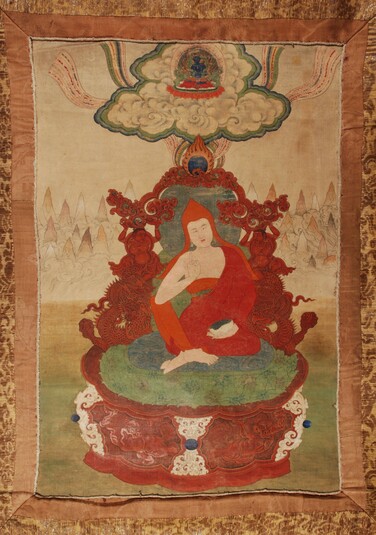
Item: Padmasambhava - (Pandita Form)
| Origin Location | Tibet |
|---|---|
| Date Range | 1700 - 1799 |
| Lineages | Karma (Kagyu) and Buddhist |
| Material | Ground Mineral Pigment on Cotton |
| Collection | Rubin Museum of Art |
Classification: Deity
Appearance: Monastic
Gender: Male
Summary: Padmasambhava can appear both as a human and as a deity.
Padmasambhava, Guru Rinpoche (Tibetan: pe ma jung ne. English: Lotus Born): one of the three principal founders of Buddhism in Tibet. (See Padmasambhava Life-story Painting).
 Pemasambhava
Pemasambhava  Pema Jungne
Pema Jungne  Biographical Details
Biographical Details
"Miraculous buddha arising from a lotus, unborn, undying, possessing a vajra body, performing the activity of all buddhas of the three times; homage to Padmasambhava." (Nyingma liturgical verse).
Amongst Tibetans, the most popular among the many teachers to bring Buddhism to Tibet in the 8th century, Padmasambhava has numerous forms representing outer, inner and secret aspects. Within the Kama (Oral) Tradition of the Nyingmapa School, Padmasambhava was born in Northern India as the son of a king or minister. In the Terma (Treasure) Tradition he was born on a lotus in the middle of Dhanakosha lake as an emanation of the Buddha Amitabha.
Jeff Watt 12-2007
Front of Painting
English Translation of Inscription: No inscriptions.
Reverse of Painting
English Translation of Inscription: No inscriptions.
Padmasambhava: Pandita/Monastic
Painting Set: Mahasiddhas, Indian Adepts - Palpung Composition II
Collection of Rubin Museum of Art: Painting Gallery 4
Collection of RMA: Best of Collection 3
Subject: Coloured Mountains Page
Painting Style: Palpung - Teachers & Siddhas
Subject: Padmasambhava Composition (Palpung)
Subject: Dragon Page



